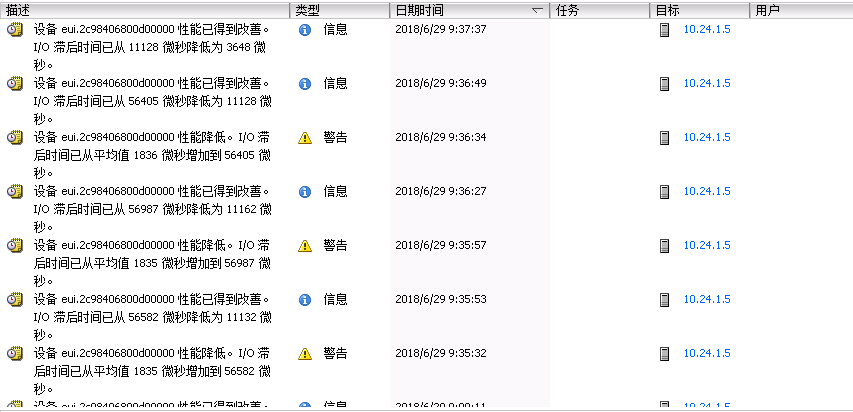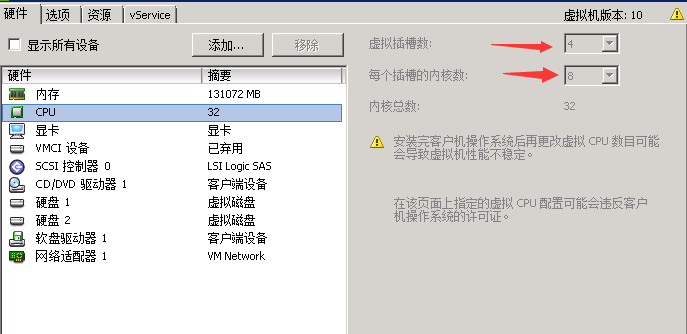服务器遇到一个问题

百度了下 基本发现是 四路的 windows 服务器的问题. 造成一些 性能降低. 然后查看了下几个虚拟机

的确是设置的4个虚拟插槽
根据百度的结果 要么改配置文件 要么改 这个四路 感觉讲四路降低成2路最简单了
建议进行处理
或许是整个事情的文档记录
然后解决办法为:
先mark 一下 再慢慢看解决方案 组要是还没看懂。
http://blog.sina.com.cn/s/blog_004175870101mzfl.html
VM的网站
https://kb.vmware.com/s/article/2231

设备 naa.6006016004102900751132ac8de3e211 性能降低。I/O 滞后时间
已从平均值 516 微秒增加到 10332 微秒。
导致这个原因和解决办法了:这原因是主要是有VM性能监控导致的,具体原因VMware工程师也说不清楚,解决办法是更改VM属性参数。如下截图:
Windows Virtual Machines with Latency-Sensitive I/O Workloads Can Slow Down in Four-Way SMP Configurations (2231)
Try setting the virtual machine configuration option monitor.idleLoopSpinUS = to increase the amount of time spent spinning in the idle loop (values greater than 100 and less than 4000 are recommended, for example 1000 or 2000). For example:
Schedule some down time.
Power off the virtual machine.
Add
monitor.idleLoopSpinUS = 1000
to the configuration file of the virtual machine (.vmx extension).
Note: For instructions on how to edit the .vmx file, see Tips for editing a .vmx file
Power on the virtual machine.
You can set monitor.idleLoopSpinUS = -1 to turn off the idle loop handler and allow the virtual machine to spin in its idle loop as determined by the guest operating system. However, VMware doesn't recommend using monitor.idleLoopSpinUS = -1 unless necessary, because it can cause the guest operating system to spin unnecessarily in its idle loop, resulting in unnecessary host CPU utilization possibly diverting CPU resources from other virtual machines. You can also use a one-way or two-way virtual machine.
具体您可以打开KB连接按照提示操作。
===========================
Windows Virtual Machines with Latency-Sensitive I/O Workloads Can Slow Down in Four-Way SMP Configurations (2231)
Details
Under certain conditions, four-way Windows virtual machines, and to a lesser extent, two-way Windows virtual machines may slow down compared to the same workload run in a uniprocessor virtual machine. The virtual machine also exhibits an increased amount of idle time. This can happen in cases where there is not sufficient work to keep the processors busy and when the workload has a low rate of external interrupts.
ESX Server 3.0.x includes a specialized virtual machine idle loop handler, which controls the number of microseconds a Windows SMP virtual machine spins in its idle loop before ESX Server halts the virtual machine. For ESX Server 3.0.x, the default value is 100. For some workloads, the delay caused by halting and then resuming the VCPUs causes a measurable slowdown as the number of VCPUs is increased.
Solution
Try setting the virtual machine configuration option monitor.idleLoopSpinUS = <n> to increase the amount of time spent spinning in the idle loop (values greater than 100 and less than 4000 are recommended, for example 1000 or 2000). For example:
- Schedule some down time.
- Power off the virtual machine.
- Add
monitor.idleLoopSpinUS = 1000
to the configuration file of the virtual machine (.vmx extension).
Note: For instructions on how to edit the .vmx file, see Tips for editing a .vmx file - Power on the virtual machine.
You can set monitor.idleLoopSpinUS = -1 to turn off the idle loop handler and allow the virtual machine to spin in its idle loop as determined by the guest operating system. However, VMware doesn't recommend using monitor.idleLoopSpinUS = -1 unless necessary, because it can cause the guest operating system to spin unnecessarily in its idle loop, resulting in unnecessary host CPU utilization possibly diverting CPU resources from other virtual machines. You can also use a one-way or two-way virtual machine.
Keywords
2231
Request a Product Feature
To request a new product feature or to provide feedback on a VMware product, please visit the Request a Product Feature page.